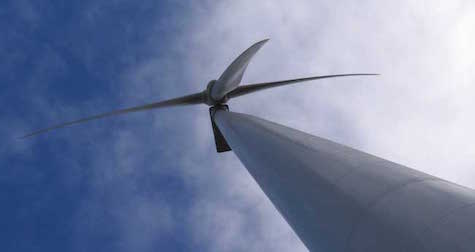County backs Barre’s new ordinance for turbines, increasing max height from 500 to 700 feet

Photo by Tom Rivers: A wind turbine is pictured on the Tug Hill Plateau in northern New York. Barre is proposing an ordinance to allow turbines that would be up to 700 feet in height.
BARRE – The Orleans County Planning Board last week voted in support of the Town of Barre proposed changes to its ordinance for wind turbines, including increasing the maximum height from 500 to 700 feet.
That change would accommodate Apex Clean Energy, which is proposing 33 wind turbines that would be a maximum 680 feet high.
If approved and built, the 184.8 megawatt project known as Heritage Wind would connect to the New York State electrical grid via an interconnection substation that would be constructed within the town along the existing National Grid Lockport-to-Mortimer 115 kV power line.
The Planning Board voted on the ordinance, and the specifics of the Heritage Wind project. County planners last Thursday recommended Barre approve the proposed ordinance. There was little discussion about the amendments.
Town Supervisor Sean Pogue described the changes as “tightening things up” in the existing code.
“What we’ve requested is more strict than what the state has,” Pogue said during the meeting, which was conducted through Zoom.
Some of the regulations proposed for the turbines include:
• Setback distances: The zoning amendments establish setbacks from property lines to be at least 1.5 times the tip height of a turbine from any public roadways or above-ground power lines, and that is for non-participating land owners or those without leases for a turbine as well as participating land owners.
For non-participating property owners (those without leases for a turbine company), the turbines would have to have setbacks at least twice the turbine height from the property line.
• Noise: The town’s proposed ordinance states noise shall not exceed 45 dBA of equivalent continuous sound for 8 hours at non-participating structures and 40 dBA at night outside at non-participating structures. The standard is 55 dBA at participating structures and 50 dBA at night for turbines at night on leaseholders’ land.
The turbines or Wind Energy Conversion Systems shall not produce human perceptible vibrations inside any non-participating structures that exceed the limits of residential use recommended in American National Standards Institute.
• Height: can not exceed 700 feet as measured from the base of the unit to the tip of unit’s longest blade. The current ordinance caps the turbine height at 500 feet tip height.
• Roads: Companies are encouraged to use existing roadways as much as possible. If that isn’t practical and a access or new roadway is needed, the turbines should be built in a way so they are level with the surrounding environment.
The wind turbine company is responsible for damages to public roads during the installation or maintenance of the turbines. The company shall post a public improvement bond prior to the issuance of a building permit. The amount shall be determined by the Town Board.
• Shadow flicker: The Wind Energy Conversion System shall be designed so the shadow flicker from each turbine will not fall on a specific area of a roadway or residential structure for more than 25 hours a year. If a turbines exceeds the 25 hours, it “shall be shut down until the offending condition is remedied,” the ordinance states.
• Construction hours: The construction hours will be limited to 6 a.m. to 8 p.m. Mondays through Saturdays except in cases of cement pours or component deliveries. Maintenance of the facilities shall be limited to the same time frames, except in cases of emergency.
• Decommissioning: at the end of the useful life or where otherwise necessary an individual turbine may need to be decommissioned or the entire project decommissioned. The applicant or its successors are responsible for decommissioning and all costs associated with it, including removing turbines, blades, nacelles, towers, transformers, above-ground collection cables and poles, permanent meteorological towers and collection substation.
Foundation and collection lines buried less than a depth of 36 inches in non-agricultural lands and less than 48 inches in agricultural lands also must be removed.
The applicant will post and maintain financial assurance in the amount of the net decommissioning costs, on a per turbine basis, to be determined by a qualified, independent engineer, at the applicant’s expense. The net decommissioning cost shall be updated a year after facility operation and then every fifth year thereafter.
• Restoration: The applicant and its successors that may own and operate the project are responsible for restoration and all costs associated with restoring the project site, including agricultural lands and public roads.
The town acknowledges that the state could pre-empt this local law though Article 10 of the NYS Public Service Law and the new 94-C of the NYS Executive Law. The state has a Siting Board to review and approve larger-scale renewable energy projects that exceed 25 megawatts. State officials have said they will try to stay within local laws as much as practical.








































































